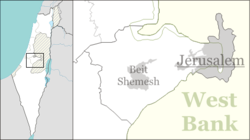Khirbet Qeiyafa Inscription

Western gate
|
|
| Alternate name | Elah fortress |
|---|---|
| Coordinates | 31°41′47″N 34°57′27″E / 31.6963°N 34.9575°E |
| History | |
| Founded | 10th-century BCE |
| Periods | Iron Age, Hellenistic |
| Site notes | |
| Excavation dates | 2007 – |
| Archaeologists | Yosef Garfinkel, Saar Ganor |
| Condition | ruin |
| Website | Khirbet Qeiyafa Archaeological Project |
Coordinates: 31°41′47″N 34°57′26″E / 31.69639°N 34.95722°E
Khirbet Qeiyafa (Elah Fortress; Hirbet Kaifeh) is the site of an ancient fortress city overlooking the Elah Valley. The ruins of the fortress were uncovered in 2007, near the Israeli city of Beit Shemesh, 30 km (20 mi) from Jerusalem. It covers nearly 2.5 ha (6 acres) and is encircled by a 700-meter-long (2,300 ft) city wall constructed of stones weighing up to eight tons each. A number of archaeologists, mainly Garfinkel and Ganor, have claimed that it might be the biblical city of Sha'arayim or Neta'im and that the large building at the center is an administrative building dating to the reign of David where King David might have lodged at some point based on their conclusions that the site dates to the early Iron IIA, ca. 1025–975 BCE, a range which includes the biblical date for the Kingdom of David. Others are sceptical, and suggest it might represent either a North Israelite, Philistine or Canaanite fortress. The techniques and interpretations used to reach the conclusion that Khirbet Qeiyafa was a fortress of King David have been criticised.
The meaning of the Arabic name of the site, Khirbet Qeiyafa, is uncertain. Scholars suggest it may mean "the place with a wide view." The modern Hebrew name, מבצר האלה, or The Elah Fortress was suggested by Foundation Stone directors David Willner and Barnea Levi Selavan at a meeting with Garfinkel and Ganor in early 2008. Garfinkel accepted the idea and excavation t-shirts with that name were produced for the 2008 and 2009 seasons. The name derives from the location of the site on the northern bank of Nahal Elah, one of six brooks that flow from the Judean mountains to the coastal plain.
...
Wikipedia

